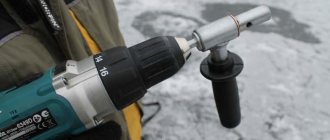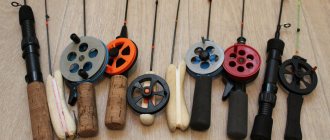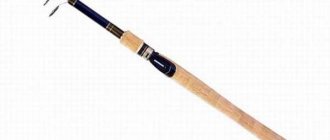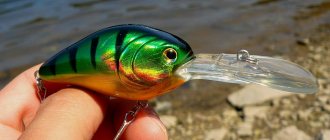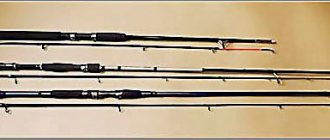Probably every winter fishing fan knows that the wise choice of ice auger and its diameter determines whether fishing will be a joy or turn into painstaking, monotonous work. To avoid possible difficulties, you should approach the choice of ice auger responsibly, but sometimes it is so easy to get lost in the variety of the presented assortment. The purpose of this article is to help you decide on the optimal diameter of the ice screw to make fishing enjoyable.
Types of ice drills
The most important difference between ice drills is the diameter of the holes being drilled, and the smaller it is, the easier and faster it can be drilled. This is especially important for those fishermen who make up to a hundred holes per day of fishing, and so that fishing does not take all the energy, the diameter size criterion should be decisive when choosing an ice drill. Most often you can find two types of ice drills in stores: sports and universal. Despite the fact that the universal one is more popular, active fishermen are still better off looking for a sports ice drill, which has a small hole drilling diameter of 90 mm.
Recently, even domestic enterprises have put drills of this diameter on the conveyor. Universal ice screws have a diameter of 100-120 mm, a similar size is also suitable for sea fishing.
Of course, when drilling a hole of small diameter, you should not expect that a fish larger than a perch will be able to easily crawl into the hole. Therefore, if the prey turns out to be large, and fishing is difficult, you should be prepared for the fact that you will have to turn to your comrades for help. Alternatively, they can drill an additional hole in the neighborhood or use an ice pick. But often, while work is being done to save the catch, the fish gets off the hook, or help turns out to be useless due to the layer of ice being too thick.
Ice drill with small diameter
However, it is not so easy to find fish in our area that exceed the permissible size, which is probably why ice screws with a small diameter are becoming increasingly popular. As mentioned above, they also have a huge advantage - they allow you to make a large number of holes per day without much effort, and this is important not only for sports fishermen. Another advantage of using sports drills with a small diameter of drilled holes is their lightness and compactness, which is important for winter fishing equipment. Taking into account all the above advantages, many fishermen, for winter vertical fishing with a spinner or a jig, use a sports-type ice drill for running fishing.
However, the situation is different if when fishing you use a float rod or jig. Here the diameter of the hole is of greater importance. Let's take a closer look at the example of bream fishing. Typically, during stationary fishing, which is suitable for catching bream and bream, anglers use an ice auger, the diameter of which ranges from 150 mm to 200 mm. A hole of this diameter is necessary for the free passage of large fish, and given that the fishing takes place in a baited area, there will be no need for a large number of holes. In addition, when going after bream, fishermen most often drag an ice auger using a sled, so the heavy weight of the equipment is no longer an obstacle to using an ice auger.
We also recommend reading:
How to properly tie a jig to a fishing line Winter fishing for gudgeon with a jig How to catch taimen in winter Winter ice pick: purpose, types, making the tool yourself
Therefore, if you prefer a stationary type of fishing, it makes sense to consider purchasing an ice drill with the largest possible blade diameter.
Choosing an ice drill for winter fishing
Home / Tackle and fishing methods / Choosing an ice drill for winter fishingWhat Russian fisherman doesn't like to quickly drill holes? A good ice auger will be useful not only to athletes, but to all Siberian fishermen, since in our climatic conditions it is impossible to do without a proper ice auger. Of course, every angler understands that buying an ice auger does not mean spending money on a jig. An ice drill is an expensive thing, it lasts quite a long time, which means it’s worth thinking about it to make the right choice.
Ice auger diameter
Selected based on the expected size of the fish being caught. A diameter of 100 mm is good for catching small fish: dace, roach, perch weighing up to 700 grams, pike up to 1 kg. Larger fish may no longer fit into a hole with such a diameter, and narrow holes freeze over in the cold much faster than wide ones. But in ordinary ordinary fishing for small fish, this diameter is in great demand: the smaller the diameter, the easier it is to drill a hole. It is ice drills with a diameter of 100 mm (there are foreign models even 90 mm) that are used by sports fishermen, since they need to drill many holes, and, as a rule, they catch small fish.
But an ice drill with a drilling diameter of 110-115 mm will be more universal for the average amateur fisherman. In such a hole you can put virtually any fish that you catch with a jig or a balancer, and in terms of drilling speed and physical effort, drilling a hole of a similar diameter is not much more difficult than a hole with a diameter of 100 mm. Agree - it’s not every day that pike larger than five kilograms are caught on a balance beam.
Ice drills that drill holes with a diameter of 130-150mm, of course, are also suitable for any fish, but most often they are bought with the intention of fishing not only with a fishing rod or balance beam, but also with girders. The 130mm diameter is good for those anglers who can only afford one ice auger. Drilling holes, of course, will be somewhat more difficult, but into such a hole you can safely pull out large pike (up to 6-7 kg), pike perch and medium-sized bream.
Well, if your target is a trophy fish: for example, a bream weighing more than 1-2 kg, a pike weighing more than 7-8 kg, then you should choose an ice drill with a drilling diameter of at least 150 mm, and preferably 175 or 200 mm. Drilling holes of this diameter is quite labor-intensive, and usually in Siberia holes of this diameter are drilled with motorized drills.
As practice shows, one ice screw is still not enough and over time, each fisherman should have 2 or even 3 ice screws in his arsenal. But if you currently do not have such a financial opportunity, then you can get out of the situation in the following way: since fishermen are sociable people and, as a rule, go fishing in the same group, then fishing friends can purchase ice screws of different diameters, and they can be used together according to fishing conditions.
Ours or “theirs”?
The short answer is, I don’t know. And this answer is not so simple and is not an excuse, and here’s why. In the case of ice augers, the price-quality ratio for our and imported ice augers is approximately the same. And it pleases. The pros and cons of ours and “theirs” are obvious and any experienced angler will report them to you. This is roughly what the pros and cons of domestic and imported (in 99% of cases Scandinavian) ice drills look like.
Domestic ice screws:
Pros:
low cost of ice screws;
cheap blades; ease of sharpening blades. Cons
: the quality of the ice auger in general; short-lived paint on the auger; blades become dull faster and sometimes are simply not of the best quality; special blades are needed for wet ice; drill holes with greater force than foreign analogues; The standard blade fastening screws are unscrewed during the drilling process and require constant tightening.
Scandinavian ice screws:
Pros:
build quality and materials;
drills ice easily; A special sharpening angle allows you to drill through any ice, dry or wet, with one blade. Cons:
the price is 3-4 times higher; a replacement head with blades costs up to 30-40% of the cost of the drill itself; sharpening of the blade is instantly deteriorated if the blade hits sand in the ice or at the bottom; difficulties with re-sharpening; When drilling a hole, the Scandinavian ice auger rotates clockwise, unlike our ice augers, which is unusual at first.
Considering all the pros and cons described above, fishermen are divided almost equally into those who believe that our ice augers are a thing of the last century, and those who do not want to pay several times more money, because in capable hands our ice auger serves just as well. Each point of view is not devoid of logic, which means there is no point in convincing both of them otherwise, and therefore I will simply try to give descriptions of the most famous models of ice screws, so that the fishermen themselves can make their own informed choice.
Of course, I did not have the opportunity to use all the ice screws described below for a long time. Yes, some of them are in constant use, some I drilled holes for what is called “testing,” borrowed from my friends. So, in order to get a true picture, I had to call friends and acquaintances, interview some sellers in fishing stores about what they and customers think about certain models of ice screws. And this is what happened in the end.
Domestic ice screws
"Pitersk" ("Leningrad") ice drill.
The main ice drill of Russian fishermen of the “era of stagnation”. It is still produced today and is quite popular among ice fishing enthusiasts. The disadvantages include a small range of models, only 2 or 3 models. There are frequent cases of breakdowns. Another disadvantage of the St. Petersburg drill is the very small wing on the attachment of the handle and auger. When frozen with ice, it is simply impossible not only to unscrew it, but even to find it.
In recent years, St. Petersburg residents began to produce titanium drills with two and three blades. Of course, these ice screws are very light and quite durable. But they also have a number of disadvantages, first of all the high price - it is even higher than that of Scandinavian drills. When drilling holes, a strong vibration was detected, which tired my hands. And three-knife drills have one more drawback - when it freezes, it is extremely difficult to remove ice from three knives.
Barnaul Boers (“Tonar”).
Unlike St. Petersburg ones, they have a wide range of models, which allows them to drill holes of different diameters from 100 to 180 mm. At the moment, these are the most popular and in demand Russian ice screws. The quality of the blades is good, and some models also have blades for wet ice, which is very important. It is completely impossible to drill the layered March and April ice with ordinary knives; the drill gets stuck in the ice and sometimes so much effort is spent drilling one hole that there is no time left for fishing. There is one more plus: you can choose an ice drill not only by diameter, but also by the height of the auger, as well as by the shape of the handle: for drilling with one hand or two-handed.
Sometimes on sale (infrequently, but it happens) you may come across knives made of unhardened metal (factory defects) that can withstand only one fishing trip; there is no point in sharpening such knives and it is better to throw them away immediately or try to exchange them in the store (if possible) for others blades.
Barnaul drills lack reliability (especially in the element mating section). A lot depends on the owner, in whose careful hands the drill can serve for ten years or more. But in general, Barnaul drills are quite well made and are worth the money they ask for.

The model range also includes a drill “Sotka Kazantseva” with a diameter of 100 mm and a long auger, which is very popular among Siberian fishermen. A very decent ice auger, in terms of price-quality ratio - probably even better than its foreign analogues. Recently, titanium drills began to be made in Barnaul. I can’t say anything about the quality of this product - there are no reviews yet.
Foreign ice screws
The leader among foreign drills - ice drills from the Swedish company Mora
. The main difference between Swedish ice drills and ours is the use of spherical blades, as well as the rotation of the drill during drilling, not counterclockwise as in St. Petersburg or Barnaul, but vice versa. But this is not critical, I didn’t feel any particular discomfort and quickly got used to it. Now I drill in one and the other direction equally and without problems, since I take domestic and foreign ice screws with me when fishing.
The range of Swedish ice drills consists of 6 models with diameters from 110 to 200 mm. You can choose not only the diameter, but also the height of the auger and even the height of the entire drill (Micro model).
Thanks to the spherical shape of the knives, holes are drilled easily and without strong pressure. You especially feel the benefits of spherical blades in March and April, when Russian ice drills have great difficulty coping with wet and flaky ice.
As always, all good things have a downside: the cutting part of Mora drills is afraid of sand. It is enough to catch the sand in the ice just a little, and the blades become unusable. There are craftsmen who know how to sharpen such blades, but there are very few of them and even they cannot always guarantee a positive result. It is almost impossible to sharpen a blade yourself, even if you have a special sharpener. Or let’s say, it’s possible to sharpen it, but it’s impossible to return it to factory quality. And the price of a spare set is steep; for this money you can buy a new Russian drill.
Swedish drills have a special technology for painting the auger - to remove ice from it, just lower the ice auger into the hole for a short time, and then easily clean it by hand. But this method only works in light frost. In our Siberian conditions, this technique does not work. For many models, the handle can be adjusted in height. All these features, plus high-quality parts and assembly, determine the cost, which is 3-4 times higher than domestic ice drills.
Finnish ice screws Rapala.
Rapala ice screws are available with a head diameter of 90-180mm.
Finnish drills differ from other ice drills in that they are not equipped with cutting knives or a spherical blade, but with removable cutting heads. Finnish ice drills come in two types: some fold in half, like Russian ones, others have a solid long auger, and for transportation, only the handle of such a drill folds. With such an ice drill it is impossible to disturb the alignment of the upper and lower parts. With the help of such a drill, you can even drill inclined holes or drill out nearby holes.
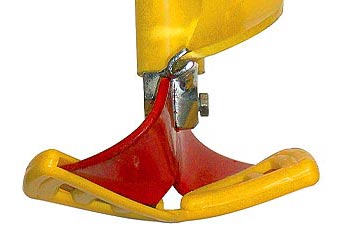
The Rapala ice auger can use a replaceable head with a larger diameter; the seats for all ice augers are unified and do not depend on size. Of course, with a head of a larger diameter, the auger will not be able to cope and throw out all the ice, and therefore, in this configuration, the ice auger will need to be taken out of the hole more often and shake off the ice crumbs.
As with Mora ice augers, Rapala knives are very difficult to sharpen at home, and the price of replacement Rapala cutting heads is again almost half the price of a new auger. But if you fish on lakes without sand in the ice, then this drill will serve you for several years with one blade. It should also be noted that such blades wear out much less and can not be sharpened for years.
As I warned at the very beginning: which ice screw to choose is up to you and only you. If I had to choose, I would probably compromise: I bought a Barnaul drill with a diameter of 100 mm and a Scandinavian drill with a diameter of 130-150.
Ice auger care
- When fishing, try not to put a wet drill in the snow - ice will immediately form on the auger. Try to leave the ice screw in a vertical position screwed to a depth of 5-10 cm into the ice.
- After fishing, taking the ice auger into a warm room, wipe the ice auger blades dry with a cloth. Whatever the material from which the blades are made, if they are not wiped and dried, sooner or later rust will appear on them. When putting away the ice screw for summer storage, it doesn’t hurt to lubricate the blades with machine oil.
- Under no circumstances should cutting knives be slammed on ice, much less on any other hard surface.
- Do not knock frozen ice off the blades. The ice must either be melted in a warm room, or the ice screw must be lowered into the hole and wait until the ice thaws. As a last resort, you can peel or scrape the ice, but do not knock.
- The augers on foreign ice drills are cleaned either by lowering them into a hole; in extreme cases, the ice can be broken off with a wooden stick. If there is not enough paint on the auger, then the ice will begin to freeze tightly on the bare spots, so try to knock the ice off the auger only in extreme cases.
- On a folding drill, periodically lubricate the junction of the elbows.
- Transport ice augers in a sled only in folded form with a protective cover on the blades. Sleigh passengers have repeatedly suffered from unassembled ice screws.
- Always carry a simple repair kit with you: a screwdriver, a wrench and spare bolts for the blades.
Konstantin Fadeev
Replaceable augers
Domestic manufacturers today offer an option that is convenient for many fishermen - replaceable augers. Thus, many fishing enthusiasts no longer need to purchase several ice screws of different diameters at once; it is enough to buy one with replaceable augers, and, depending on the type of fishing, change attachments as needed. This significantly saves not only the space occupied by fishing tackle, but also the budget, since the cost of a replacement auger usually does not exceed one-fourth the cost of a new ice auger. We recommend that you find out why you need an ice pick for winter fishing.
Knives
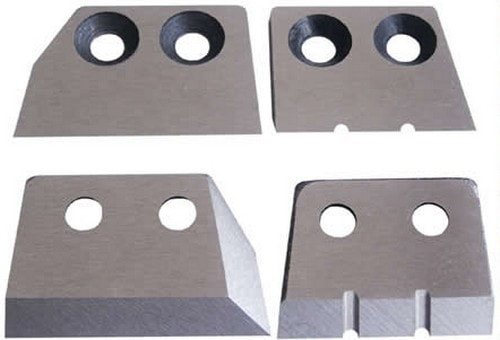
Ice screws are equipped with:
- Knives;
- Cutting head.
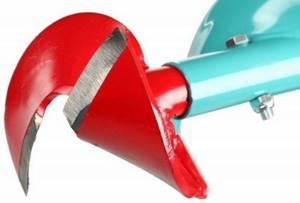
Domestic models are produced with replaceable knives, which, if you have certain skills, can be sharpened yourself or replaced with new ones.
To understand how to choose an ice auger with replaceable knives, you need to know that they come in:
- Flat;
- Spherical.
Russian ice screws are equipped with flat knives, imported ones, as a rule, are equipped with spherical ones, although there are exceptions.
You won’t be able to sharpen spherical knives yourself, but they do an excellent job with porous ice and old, frozen holes.
The cutting head, if it breaks, will have to be completely replaced.
Ice auger diameter depending on fish
In the last part of the article I would like to give advice regarding the diameter of the ice drill when catching a particular fish. I would immediately like to discuss that the data given is correct if the ice thickness is 20 cm, since on thicker ice the diameter of the recommended hole also changes.
lake perch
Perch, with a characteristic hump and weighing from 500 grams to a kilogram, is best fished with a large hole diameter - from 150 mm, but if the perch is small in size (up to 300 grams), a sports-type ice drill may well be suitable, since the hole size should be about 90 mm. For average fish, a hole with a diameter of 120 mm is suitable.
Material
Ice screws are most often made from cold-rolled sheet steel with a high-quality coating over the entire surface. There are models made of titanium, but the strength and lightness of such a product completely cancels out the noise during operation; the ringing roar will scare away all the fish in the area . In addition, a lot of ice often freezes on titanium products when the thermometer readings are low.
Iron is rarely used; the strength of such a product will be high, but the weight will not allow it to be moved over long distances.
For convenience, the handles are covered with hard rubber; such material is comfortable to hold on to, it prevents slipping, and does not give frost to your hands.
Ice auger knives are made from high quality steel.




